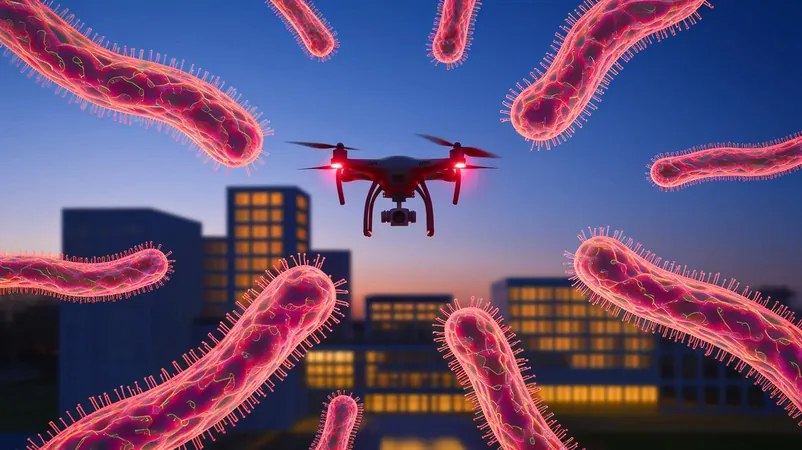
MIT's Revolutionary Glowing Bacteria Are Now Communicating with Drones!
2025-04-13
Author: Yu
A Stunning Breakthrough in Bacterial Technology
In a groundbreaking fusion of biology and technology, researchers at MIT have engineered bacteria that emit light in both visible and infrared spectrums. This innovation allows these tiny organisms to communicate chemical signals over impressive distances, effectively transforming them into living sensors capable of relaying crucial information to drones or satellites equipped with hyperspectral cameras. This article explores the science behind this monumental leap, its potential applications, and the wide-reaching implications for various sectors.
Transforming Bacterial Communication
Traditionally, modified bacteria have served as sensors to detect pollutants or nutrients within soil, yet their application in the field was hampered by the need for specialized imaging equipment. MIT’s latest development has shattered these limitations! The researchers have created bacteria that emit unique optical signatures in response to specific chemicals, which can be captured from distances of up to 295 feet by hyperspectral cameras, vastly enhancing the utility of these biological sensors.
How It Works: The Magic of Hyperspectral Reporters
The real marvel lies in modifying bacteria to emit light when they come into contact with certain chemicals. When activated, these genetically engineered bacteria produce molecules called hyperspectral reporters. This innovation allows drones to capture emitted light from far away, revolutionizing our approach to gathering data from biological systems. Christopher Voigt, a senior author of the study, claims that this technology enables a deeper understanding of cellular behavior without direct observation.
Real-World Testing: Bacteria in Action
Field tests have demonstrated the bacteria’s potential in various environments. Placed in secure boxes and deployed on rooftops and desert plots, drones equipped with hyperspectral cameras rapidly scanned these locations, revealing which bacteria were actively signaling. With this swift scanning process taking under 30 seconds per field, researchers are showcasing an efficient and actionable system.
From Precision Agriculture to Environmental Safety
This innovative technology has already proven adept at detecting elements like arsenic. Its adaptability opens doors for applications ranging from monitoring soil nutrients to environmental safety checks, including landmine detection. The idea of engineering bacteria to function within plant cells adds further dimensions, allowing entire ecosystems to 'speak' through light signals visible to aerial surveillance.
The Genetic Backbone: Crafting Light-Emitting Bacteria
At the heart of this advancement is the genetic engineering of bacteria to produce light through hyperspectral reporters—molecules intricately linked to the bacteria’s sensor circuits. Researchers leveraged quantum calculations to analyze around 20,000 natural cell compounds, discovering two main candidates: biliverdin, derived from heme breakdown, and bacteriochlorophyll, a pigment involved in photosynthesis. These compounds are not only distinguishable from others but are also easily produced by the bacteria, allowing for efficient signal detection.
Looking Ahead: Expanding Horizons
The implications of this technology are vast, particularly in agriculture where it may redefine soil health monitoring while minimizing environmental impact. It also holds potential for detecting hazardous substances and could even extend to medical diagnostics and industrial applications. Nevertheless, the introduction of such biological technology invites discussions about regulatory oversight and safety protocols to ensure its responsible use.



 Brasil (PT)
Brasil (PT)
 Canada (EN)
Canada (EN)
 Chile (ES)
Chile (ES)
 Česko (CS)
Česko (CS)
 대한민국 (KO)
대한민국 (KO)
 España (ES)
España (ES)
 France (FR)
France (FR)
 Hong Kong (EN)
Hong Kong (EN)
 Italia (IT)
Italia (IT)
 日本 (JA)
日本 (JA)
 Magyarország (HU)
Magyarország (HU)
 Norge (NO)
Norge (NO)
 Polska (PL)
Polska (PL)
 Schweiz (DE)
Schweiz (DE)
 Singapore (EN)
Singapore (EN)
 Sverige (SV)
Sverige (SV)
 Suomi (FI)
Suomi (FI)
 Türkiye (TR)
Türkiye (TR)
 الإمارات العربية المتحدة (AR)
الإمارات العربية المتحدة (AR)